Feb 13, 2018
PepsiCo leans more heavily on snacks as beverages fizzle
, Bloomberg News

PepsiCo Inc.’s snacks are having to pick up more of the slack for its ailing beverages.
The company posted sales and earnings that topped analysts’ estimates last quarter, helped by an uptick in volume at its Frito Lay business in North America. The snack growth helped offset continued declines at the Purchase, New York-based company’s drinks business. Still, a disappointing forecast suggests that PepsiCo has more struggles ahead.
The story is familiar: As sugar-wary consumers turn away from sweet beverages, the company has relied more on food to bolster results. The maker of Mountain Dew and Cheetos is also benefiting from cost cuts, with Chief Executive Officer Indra Nooyi pursuing at least US$1 billion in annual savings.
“We delivered these results in the midst of a dynamic retail environment and rapidly shifting consumer landscape,” Nooyi said in a statement.
PepsiCo’s success with snacks is a sign that Frito Lay is innovating -- examples include Organic Doritos and yogurt-based crackers -- while simultaneously strengthening its core brands. But it hasn’t been able to pull off the same trick on the beverage side. North America Beverage sales volumes were down 2 per cent in the fourth quarter.
Core earnings amounted to US$1.31 share in the period. Analysts estimated US$1.30, on average. Revenue was US$19.5 billion, compared with analysts’ prediction of US$19.4 billion.
TEPID OUTLOOK
But PepsiCo’s forecast for this year was less impressive. The company sees earnings of US$5.70 a share, 8 cents short of the average Wall Street estimate.
The stock gained less than 1 per cent to US$12.50 in early trading. It had lost 6.7 per cent this year through Monday’s close.
The company also announced that it will pay bonuses of up to US$1,000 for some employees following the U.S. tax overhaul, joining companies such as Home Depot Inc. and Walt Disney Co. in doling out perks.
PepsiCo and beverage rival Coca-Cola are both aiming to solve the declining popularity of their products with new innovations. Consumption of carbonated soft drinks fell to a 31-year low in the U.S. in 2016, according to Beverage-Digest, a trade publication.
PepsiCo has set a limit of 100 calories per 12-ounce serving for two-thirds of its beverages, a goal it seeks to meet by 2025. The company is also pledging to reduce sodium and saturated fat in its snacks.
Its new sparkling water, Bubly, targets consumers who want better-for-you products -- a group that’s driven the growth of National Beverage Corp.’s LaCroix. But LaCroix’s success has caused competition to heat up in the segment: Nestle SA, which owns Perrier and Poland Spring, is also boosting its bubbly offerings through its regional water brands.


